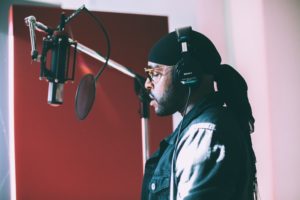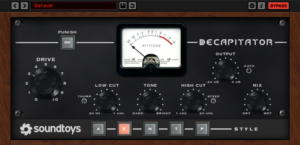Double tracking vocals involves having your vocalist sing the exact same part of a song on a second track. This “vocal double” is then blended with the main vocal track, to enhance it’s sound. In a strange way it tends to be both an underrated and overrated tool in the music recording world.
Double tracking vocals is my guilty pleasure
— *Trips (@chipsbarranco) May 21, 2019
Perhaps a better word to describe it is misused, as those who love double tracking vocals usually overdue it an unnatural amount. On the other hand, if you dislike the technique it’s probably because you’ve only ever used it in this overdone fashion. You may not even be aware of its power when subtly utilized.
The tips below will clear up the air around double tracking vocals, offering both basic and professional approaches. After going through them all, you’ll have a deeper understanding and greater appreciation for how double tracking can improve the vocals in your home recordings.
1. Get a Clean Vocal Double
When tracking vocals it’s important to take the time to get a well performed vocal double. If you’ve spent a while tracking a pristine main vocal, try doing more than a quick pass for the double.
https://twitter.com/godakagarlic/status/591350021477552128
As mentioned above, it can also take a skilled vocalist to track a clean vocal double. This is because you want to get a take that follows the same melody, in lyrics and rhythm of the main track.
If you have the time, you can make things easier on the singer by to comping your lead vocals before tracking the double. This way your singer will be able to match the main take as best as possible for an even more cohesive sound.
2. Don’t Clean It Too Much
At the same time you don’t want to over produce your double so it’s exactly the same as the main vocals. A mistake is to go through and edit your vocal double so that every word lines up perfectly with the lead vocal track.
That’s not to say this isn’t is a handy approach to tighten things up in areas that are extremely off. However, going too far with it can remove the purpose of why double tracking vocals is effective in the first place.

Your vocal double should follow the same rhythm and melody but doesn’t need to be perfectly in sync with the lead.
You want there to be a very slight uniqueness to how the vocal double is synched with the lead. This is what helps thicken and fill out the overall sound of the lead vocal track.
3. Double Track Vocals Even If You Don’t Think You’ll Use It
If time and budget allow, it’s always worth taking a portion of the tracking session to double the vocals. Whenever possible record one, regardless of whether you envision it in the final mix or not.
It’s better to have it and not need it, than to need it but not have it. This is especially true when you’re not the one mixing a song. Although you may not picture the classic vocal double sound, a mixing engineer may use it as a tool in a completely different way than you picture.
The result can be a big improvement on the vocal sound than if you didn’t have a double for them to work with.
4. Don’t Always Pan Your Vocal Double
Once the tracking is complete and a song is ready to be mixed, panning tends to be a common approach for vocal doubles. The method is pretty self-explanatory and involves panning one vocal hard left and the other hard right.
Double tracking these vocals like it’s going out of style. (Which it probably has…)
— andrewosenga (@andrewosenga) August 16, 2017
This approach is used a lot but I don’t necessarily recommend it. It’s a great way to get that lo-fi, John Lennon type sound but that’s not always what a song calls for.
The difference in deliverance can also make things distracting once played back. Because of this there may be sections where your listeners ear is pulled to the left or right side.
Instead, I prefer using the double in a way that isn’t obvious to the listener. Having both tracks panned in the centre and lightly blending in the double will create a cohesive sound.
5. Remove High End
When double tracking vocals and mixing both up the centre, a lesser known approach is to remove high frequency content from the double.
I do this by using an EQ plugin with a high shelf to attenuate anything above the 4kHz and 6kHz range. When the vocal’s soloed this may not seem like a great choice. However, you want it to sound almost like the vocal double is singing behind a blanket.
This does two things for the song. First, by removing some presence it places the double further back in the mix, behind the main vocals. Second, it removes any unnecessary sibilance in the double. You may even try using an aggressive de esser on the double vocal to achieve this.
By taking away the definition of the double’s phrasing it allows the main vocal to provide all the sibilance. Then the vocal double simply thickens the body of the main vocal in the track.
6. Parallel Process The Vocal Double
There are hundreds of unique and impactful processing plugins out there, some much more aggressive than others. A great way to reap the benefits of these effects while still retaining the integrity of the original recording is to use parallel processing on the double.
Keep the lead vocal clean and unaffected, but place an enhancing effect on the vocal double. Then, mix in the double so your barely notice the presence of it but notice it’s effects on the main track.
Examples of effects you may want to use on your vocal double include a slight spread/delay plugin (Eg Soundtoys’ MicroShift) or aggressive compression/harmonic distortion (Soundtoys’ Devil-Loc or Decapitator).
It doesn’t fit every song or double tracking situation. However, when it works it can do a lot to bring out the vocals in your mix.
7. Use The Double For Emphasized Sections
Another extremely effective technique when double tracking vocals is to edit them so they are only present in certain parts of the song. For example, these might be areas such as the chorus, bridge or second verse, places you want to hit a little harder.
When recording vocals try double tracking only certain words/phrases to emphasise them. #homestudio #mixing #mixtips #recording pic.twitter.com/1m3H3Yp0gb
— Vortis Sound Studios (@VortisStudios) September 18, 2018
By only double tracking the vocals for these parts, it’ll take the vocals up a notch when compared to other song sections.
8. Double Track Backing Vocals
This may be something you already do since it’s much more standard than double tracking lead vocals. However, if you haven’t utilized the technique before give it a try. I guarantee it will soon become your go to method for tracking backup vocals.
Back-up vocals and harmonies have a different sound than lead vocals. You want them to be present but not to overstep the main part. Because of this you usually want to pull them back a fair bit. Also, pan them left and right to help them fill out the stereo spectrum and leave space for the lead vocals in the centre.
Depending on the part, you may want to EQ them similarly to a vocal double, removing some high end. Once again, this is because the sibilance will be provided by the lead vocal.
9. Less Is More When Double Tracking Lead Vocals
If you’re going for a super wide spread or that spacey, John-Lennon sound, you very well may want to match your lead vocals level with the double.
However, more often than not you’ll use the double simply to augment and enhance the main vocal track. In these cases don’t go overboard with the level of the vocal double. You shouldn’t really hear it’s presence in the mix but will notice it when it’s not there.
Conclusion: Double Tracking Vocals
Doubling remains a highly misused technique for tracking vocals. Many people don’t realize the affect it can have on a song and how much variety available when mixing.
I love double tracking vocals. Sounds so goooood.
— Aled Phillips (@aledsavedlatin) June 21, 2015
Going forward, always remember to take the time to record a clean vocal. It should match the main track without being hyper-edited to be perfectly lined up.
Once mixing, don’t always pan your tracks left and right unless they’re back up vocals. Removing the high end and sibilance or processing it with a different sound is another approach. This all will ensure that the vocal doubles sole purpose is to fill out and support the main vocal and not distract form it.
If you found these tips helpful, head over to the Sundown Sessions blog for more tips on vocal recording and mixing music.




